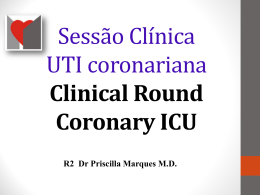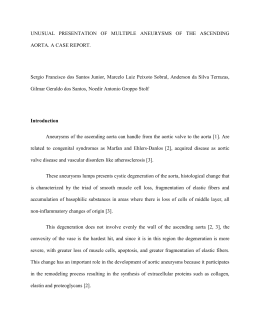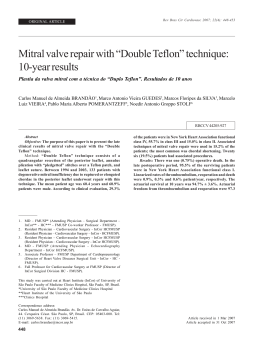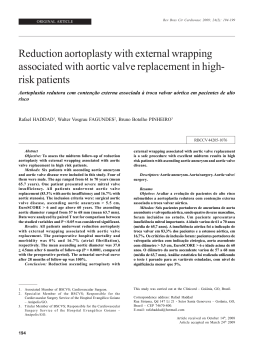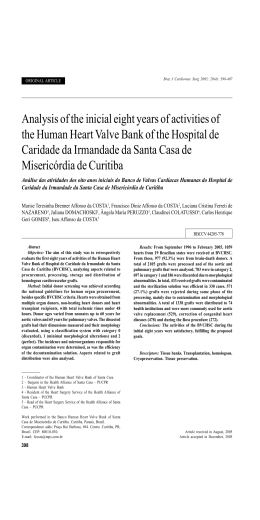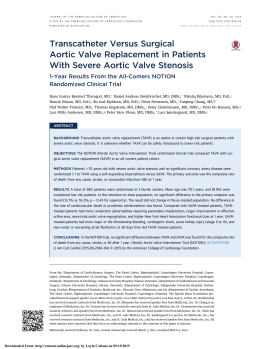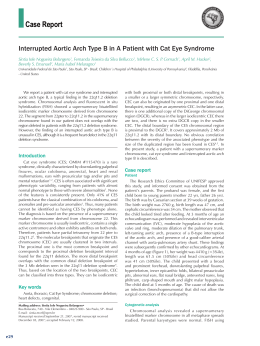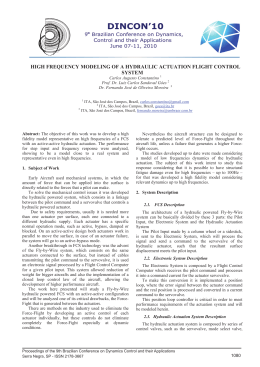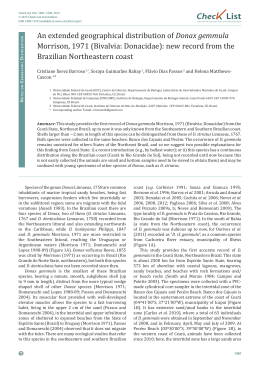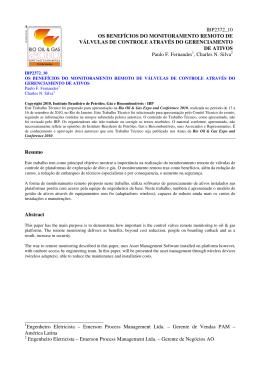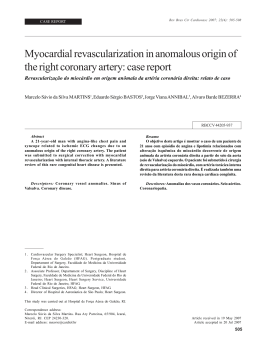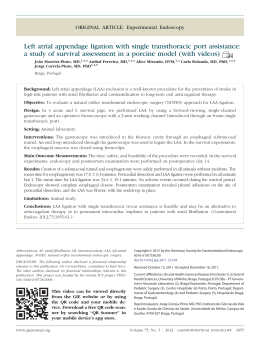Double Orifice Mitral Valve in an Asymptomatic Adult with an Unusual Combination of Congenital Malformations: A Case Report [16] GONÇALO PROENÇA, ANTÓNIO FREITAS, SÉRGIO BAPTISTA, BOBAN THOMAS, JOSÉ FRAGATA, RAFAEL FERREIRA Serviço de Cardiologia, Hospital Fernando da Fonseca Amadora, Portugal Rev Port Cardiol 2004; 23 (2) : 233-236 ABSTRACT We report a case of an asymptomatic adult patient, with several congenital malformations including an infrequent variant of double orifice mitral valve, postductal aortic coarctation, bicuspid aortic valve and an aneurysm of the right Valsalva sinus. The loss of support of the right coronary cusp of the aortic valve caused major aortic regurgitation. With the exception of the mitral valve, which was left untouched because it was neither stenotic nor regurgitant, all the other abnormalities were successfully corrected, in a two-step surgical approach. Key words Double orifice mitral valve; Aortic coarctation; Bicuspid aortic valve; Aneurysm of the Valsalva sinus; Aortic regurgitation CASE REPORT W e present the case of a 32-year-old man who was referred to our department due to a systolic murmur detected on a routine medical examination. He was asymptomatic, performing heavy duties and practicing sports. RESUMO Duplo Orifício Valvular Mitral em Adulto Assintomático com Combinação Pouco Usual de Malformações Congénitas: A Propósito de um Caso Clínico Os autores apresentam o caso clínico de um adulto assintomático, referenciado para esclarecimento de um sopro sistólico, em que se diagnosticou um conjunto de malformações congénitas incluindo duplo orifício valvular mitral, coarctação da aorta, bicuspidia aórtica e aneurisma do seio de valsalva direito. Este último condicionava ainda perda de suporte da cúspide coronária direita e regurgitação aórtica major. Com excepção da válvula mitral que, por não apresentar alterações funcionais, não foi corrigida, todas as outras anomalias foram objecto de correcção cirúrgica, em duas etapas. Palavras-Chave Cardiopatia congénita; Duplo orifício valvular mitral; Coarctação da aorta; Bicuspidia aórtica; Aneurisma de seio de Valsalva; Insuficiência aórtica On physical examination his blood pressure was 150/70 mmHg in the right arm and 110/70 mmHg in the left leg. The radial pulse was regular, rhythmic, and had normal amplitude. By contrast, the femoral arterial pulses were difficult to detect and clearly delayed relative to the radial pulse. Breath sounds were normal Recebido para publicação: Julho de 2003 • Aceite para publicação: Dezembro de 2003 Received for publication: July 2003 • Accepted for publication: December 2003 233 but on cardiac auscultation an S4 was heard at the apex as well as a systolic and protodiastolic grade II/VI aortic murmur. The upper and lower extremities were equally developed and no abnormal collateral circulation was seen on the chest wall. The ECG showed AQRS left axis deviation with left anterior fascicular block. On the chest X-ray there was extensive bilateral and symmetrical rib notching, an increased cardiothoracic index, and the classic inverted 3 sign (Fig. 1). The transthoracic and transesophageal echocardiograms revealed a bicuspid aortic valve, an outlet defect of the interventricular septum (aneurysm of the right Valsalva sinus) causing loss of support to the right coronary cusp, and major aortic regurgitation. The left ventricle was slightly enlarged. We could also see a markedly dilated aortic root and supra- aortic branches. In suprasternal view the descending thoracic aorta seemed to be cut off. Surprisingly, there were two normally functioning mitral valve orifices (Figs. 2, 3, 4), roughly the same size, with a central fibrous subdivision. No regurgitation or stenosis was detected. There was neither atrial nor ventricular septal defect. Magnetic resonance imaging confirmed extensive aortic coarctation (Fig. 5). Finally, prior to surgery, cardiac catheterisation confirmed the diagnosis, excluding coronary artery malformation and demonstrating a transcoarctation gradient of 55 mmHg. The patient successfully underwent surgical correction of the aortic coarctation with a patch of bovine pericardium. Four months later, he started complaining of fatigue in his daily activities and the echocardiogram revealed further left ventricular enlargement. The aortic valve Fig. 1-A Enlarged left ventricle, frontal view and inverted 3 sign (arrow); B - Frontal view – zoom, with rib notching (arrow). 234 Fig. 2. Transesophageal transgastric short-axis view (A), at the level of the mitral valve showing two separate mitral valve orifices (asterisks). The posterior orifice is larger than the anterior. (B) Transgastric longitudinal view showing two mitral valve orifices (arrow). LA = left atrium; LV = left ventricle. Fig. 3 Transesophageal longitudinal two-chamber view in systole (A) and diastole (B) showing two separate mitral valve orifices, with a central bridge that connects the two orifices. LA = left atrium; LV = left ventricle. Fig. 4 Transesophageal aortic valve short-axis view demonstrating a bicuspid aortic valve with aneurysm of the anterior Valsalva sinus (arrow). Ao = aorta; RA = right atrium; LA = left atrium; PA = pulmonary artery. Fig. 5 Contrast-enhanced MRI showing post-ductal aortic coarctation and numerous collaterals. was then replaced by a St Jude 25 ® mechanical prosthesis and the Valsalva sinus aneurysm was closed by suturing its isthmus. Three months after the second operation, he had resumed his job and was again asymptomatic. two major types of DOMV. The most common is called double parachute or hole type MV (85 % of cases), because there is a smaller accessory orifice at either the anteroseptal or posteromedial commissure and a larger main orifice, and both insert exclusively in one papillary muscle. It is usually associated with other anomalies of the MV apparatus. Only five (15 %) of these cases resembled our patient’s with two separate mitral orifices approximately equal in size, with separate leaflet structures, due to the presence of a central fibrous subdivision (central type). Frequently, this abnormality is associated with other cardiac malformations such as ventricular septal defect, bicuspid aortic valve, coarctation of the aorta and, most commonly, atrio-ventricular septal defects (2, 3). The morphology as well as the presence of significant DISCUSSION Double orifice mitral valve (DOMV) is a rare congenital malformation, first described by Greenfield in 1876. It is characterized by a mitral valve (MV) with a single fibrous annulus and two orifices opening into the left ventricle (LV). Subvalvular structures, especially the tensor apparatus, may show varying degrees of abnormalities. In the largest published series, Baño-Rodrigo and co-workers reported on twenty-seven post-mortem pediatric cases (1). They described 235 regurgitation or stenosis can usually be clearly delineated by transthoracic or transesophageal echocardiography (4). However, diagnosis is not always straightforward. In a series of 549 patients who had surgical repair of atrioventricular septal defects (21 patients had associated DOMV), a high percentage of missed diagnosis on preoperative transthoracic echocardiography was reported, stressing the need for careful observation in parasternal short axis view. In this report, DOMV was the most frequently missed lesion (14 of 21 cases) (5). REFERENCES 1. Baño-Rodrigo A, van Praagh S, Growitzsch E, van Praagh R. Double orifice mitral valve: a study of 27 postmortem cases with developmental, diagnostic and surgical considerations. Am J Cardiol 1988;61:152-60. 2. Purnode P, Rombaut E, Alkhori M, Marchandise B. Double orifice mitral valve with flail leaflet: a transesophageal echocardiographic examination. Eur J Echocardiography 2000;1:144-16. 3. Sousa R, Correia D. Válvula mitral com duplo orifício. A propósito de um caso clínico. Rev Port Cardiol 1995;14(3): 233-8. 4. Solorio S, Badui E, Yanez M, Enciso R, Rodriguez L, Quintero LR. Double mitral valve orifice. Two dimensional and Doppler echocardiographic diagnoses. Arch Med Res 1996;27(4):491-4 (Abs.) 5. Sittiwangkul R, Ma R., McCrindle B, Coles J. Smallhorn J. Echocardiographic assessment of obstructive lesions in atrioventricular septal defects. JACC 2001;38:253-61. Address for reprints: Pedidos de separatas para: GONÇALO MIRANDA PROENÇA Hospital Fernando da Fonseca Serviço de Cardiologia (Piso 4 – Torre Amadora) IC 19 2720-276 AMADORA, PORTUGAL e-mail: [email protected] Fax: 21-4348466 236
Download
